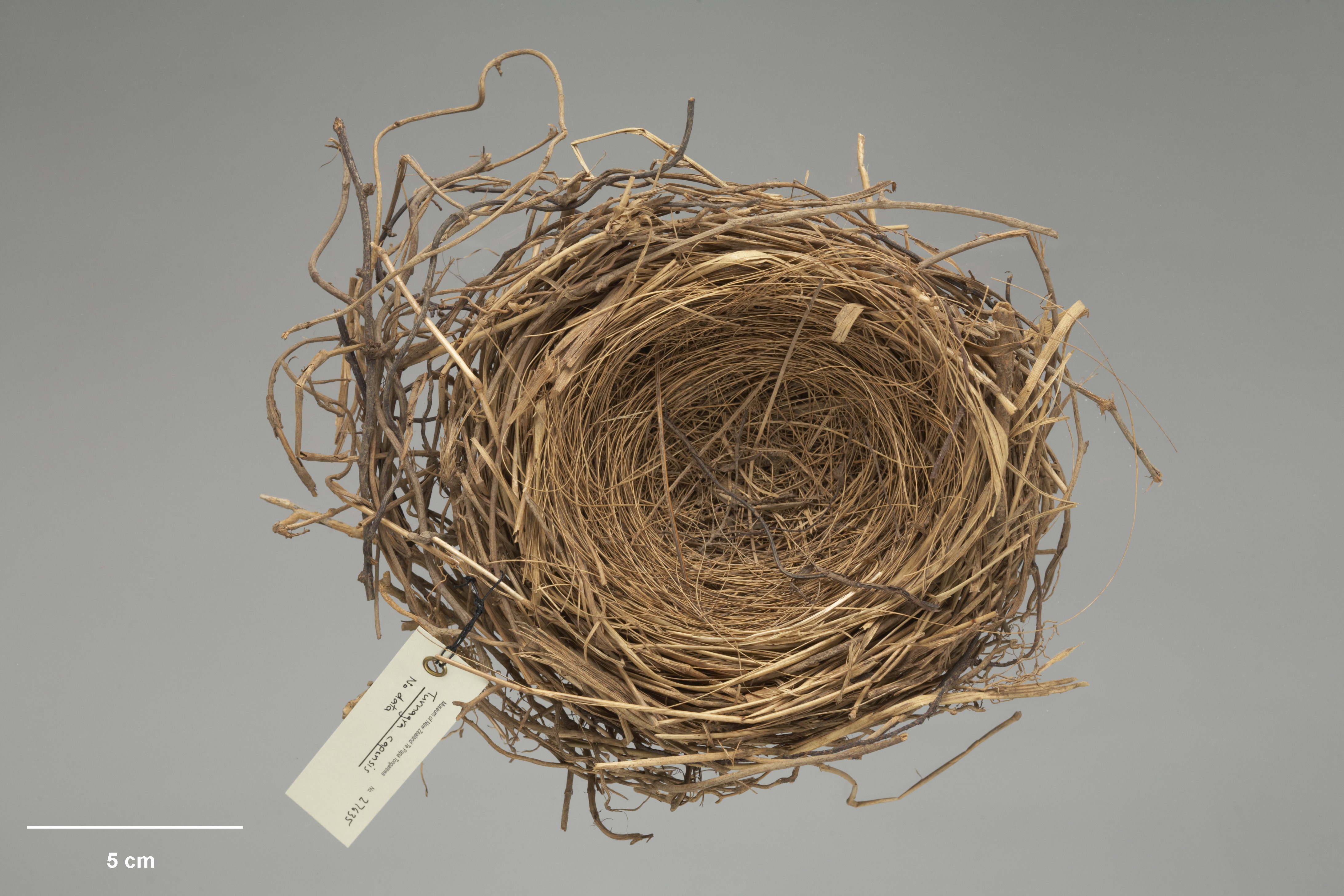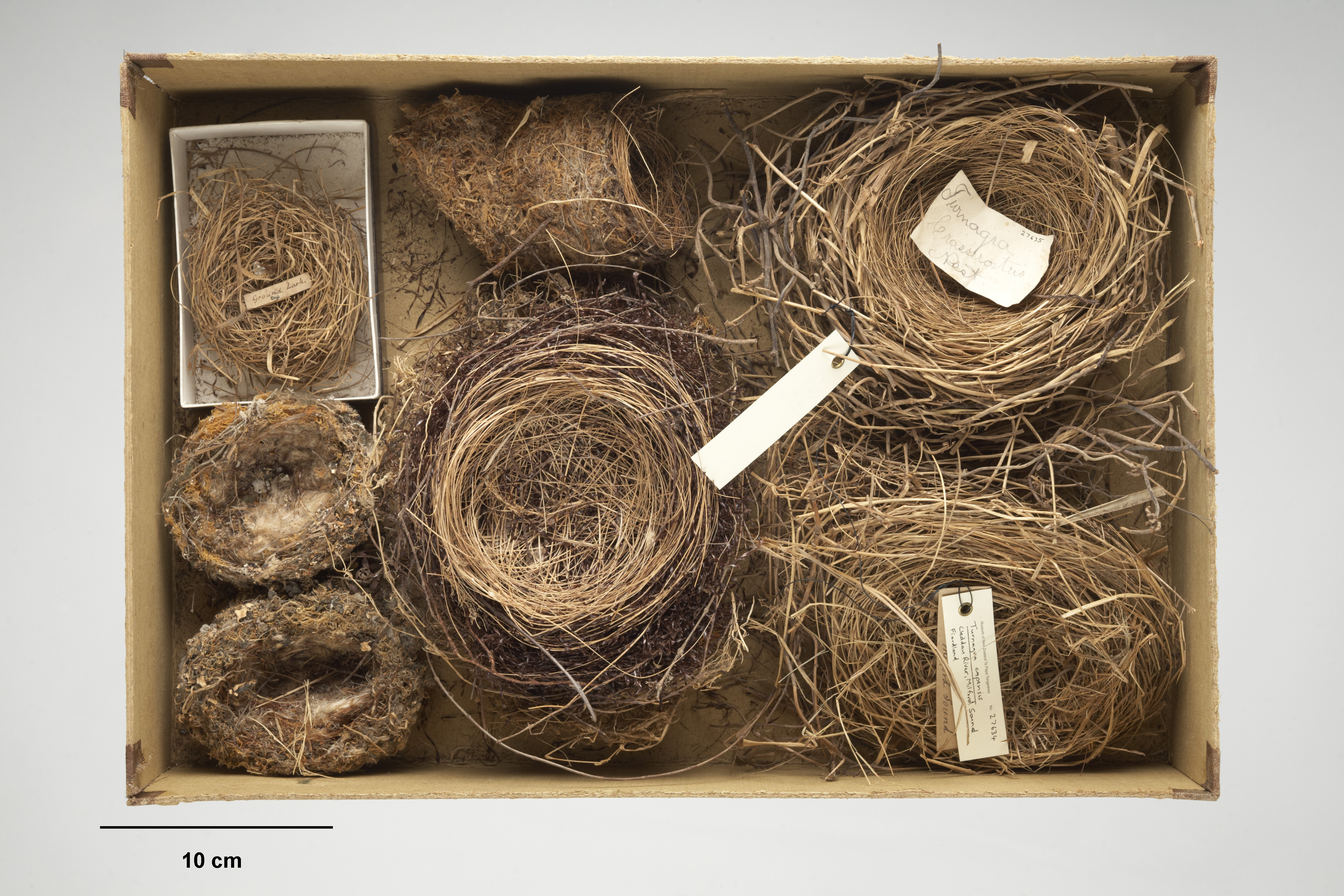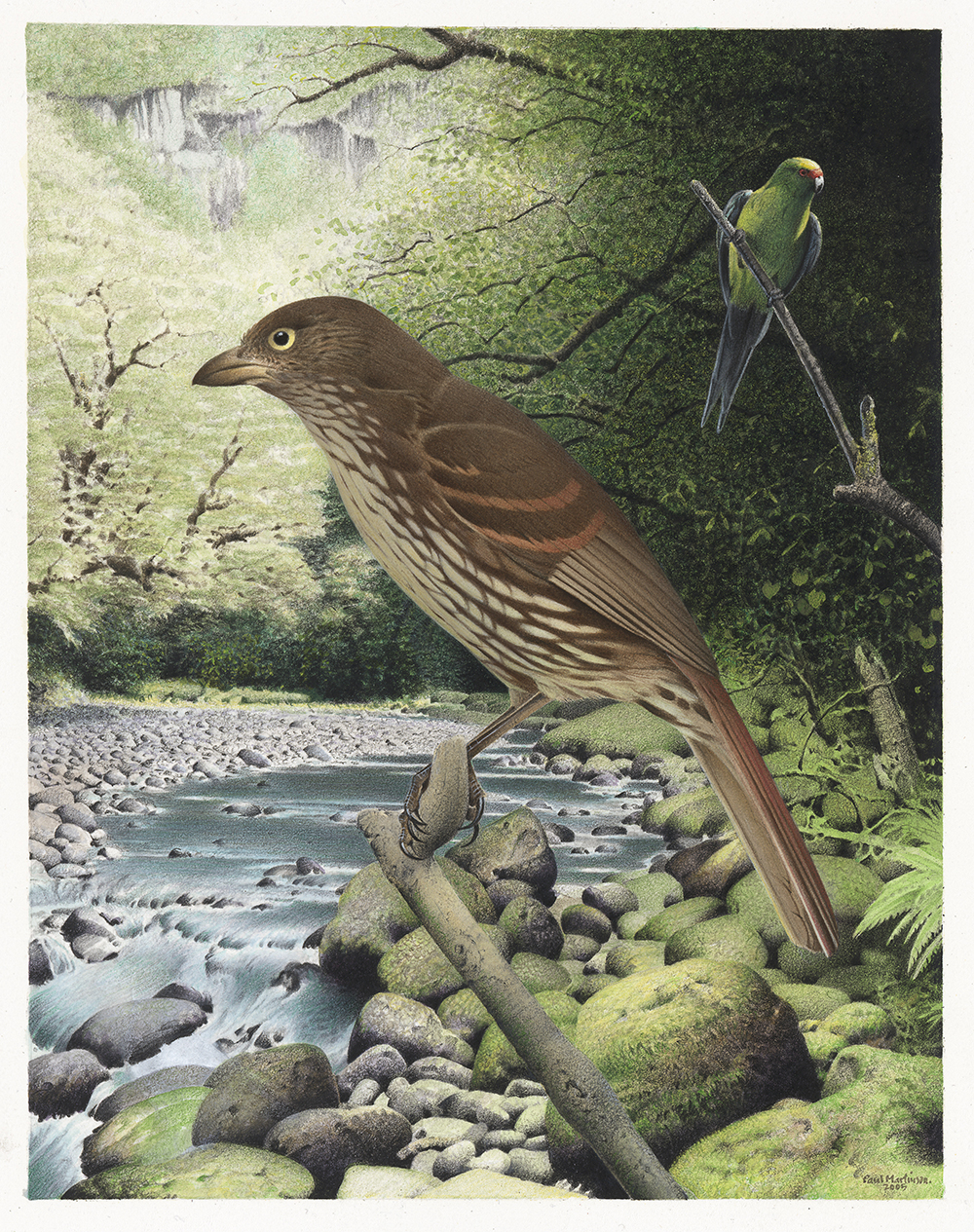Turnagra capensis capensis Sparrman, 1787
South Island piopio, Piopio, New Zealand thrush, Piopio (Māori)
Taxonomy & Nomenclature
A complete synonymy taken from (Checklist Committee (OSNZ), 2022:212):
Tanagra capensis Sparrman, 1787: Mus. Carlsonianum 2: no XLV, pl. 45 – “Cape of Good Hope”, error for Dusky or Queen Charlotte Sound (fide Oliver 1930, New Zealand Birds, 1st edition: 447).;
Turdus crassirostris Gmelin, 1789: Syst. Nat., 13th edition 1(2): 815. Based on the “Thick-billed Thrush” of Latham 1783, Gen.; Synop. Birds 2: 34, pl. 37 – Dusky Sound, Fiordland.; Campephaga ferruginea Vieillot, 1817: Nouv. Dict. Hist. Nat., nouv. éd. 10: 48 – New Zealand.; Tanagra macularia Quoy & Gaimard, 1830: in Dumont d’Urville, Voyage Astrolabe Zool. 1: 186, pl. 7, fig. 1 – Tasman Bay.; Keropia crassirostris (Gmelin); G.R. Gray 1840, List Gen. Birds (1st edition): 28.; Loxia Turdus J.R. Forster, 1844: in M.H.C. Lichtenstein, Descrip. Animalium: 85 – South Island.; Otagon turdus (J.R. Forster); Bonaparte 1851, Consp. Gen. Avium 1: 374.; Ceropia crassirostris (Gmelin); Sundevall 1857, Kungl. Svenska Vetenskapsakad. Handl. 2(3): 9.; Turnagra crassirostris (Gmelin); G.R. Gray 1862, Ibis 4: 225.; Turnagra turdus (J.R. Forster); G.R. Gray 1869, Hand-list Birds 1: 284.; Otagon crassirostris (Gmelin); Sundevall 1872, Methodi Naturalis Avium Tentamen: 19.; Turnagra capensis (Sparrman); Mathews & Iredale 1913, Ibis 1 (10th series): 445.; Turnagra capensis capensis (Sparrman); Checklist Committee 1953, Checklist N.Z. Birds: 68.
Conservation Status
Extinct
Last record: 1905 (Tennyson & Martinson, 2006; Tyrberg, 2009:103); 1947? (Tyrberg, 2009:103)
IUCN RedList status: Extinct
Unconfirmed reports:
Near Lake Hauroko, 1947 (Dunckley & Todd, 1949)
Nelson (north-west), 1948 (Moore, 1949)
Child (1965:53) believes he saw Turnagra capensis capensis on 24 May 1963.
Distribution
South Island, New Zealand
Biology & Ecology
Hypodigm
[url=http://nlbif.eti.uva.nl/naturalis/detail.php?lang=uk&id=35]RMNH 110.040[/url]
[url=http://nlbif.eti.uva.nl/naturalis/detail.php?lang=uk&id=35]RMNH 110.041[/url] (male)
[url=http://nlbif.eti.uva.nl/naturalis/detail.php?lang=uk&id=35]RMNH 110.056[/url]
[url=http://nlbif.eti.uva.nl/naturalis/detail.php?lang=uk&id=35]RMNH 110.057[/url] (adult, female)
[url=http://nlbif.eti.uva.nl/naturalis/detail.php?lang=uk&id=35]RMNH 110.058[/url] (juvenile, female)
[url=http://nlbif.eti.uva.nl/naturalis/detail.php?lang=uk&id=35]RMNH 110.059[/url] (adult, male)
Media

Above: South Island Piopio, Turnagra capensis, collected no data, New Zealand. Acquisition history unknown. CC BY 4.0. Te Papa (OR.027635)

Above: South Island Piopio, Turnagra capensis, collected no data, New Zealand. Acquisition history unknown. CC BY 4.0. Te Papa (OR.027635)

Above: South Island Piopio. Turnagra capensis. From the series: Extinct Birds of New Zealand., 2004, Masterton, by Paul Martinson. Purchased 2006. © Te Papa. CC BY-NC-ND 4.0. Te Papa (2006-0010-1/12)
References
Original scientific description:
Sparrman, A. (1787). [Turnagra capensis]. Mus. Carlsonianum 2: 45.
Other references:
Anmarkrud, Jarl Andreas and Lifjeld, Jan T. (In Press, 2016). Complete mitochondrial genomes of eleven extinct or possibly extinct bird species. Molecular Ecology Resources. DOI: 10.1111/1755-0998.12600 [Abstract]
Anonymous. (1964). List of rare birds, including those thought to be so but of which detailed information is still lacking. IUCN Bulletin 10(Special Supplement): 4 pp.
BirdLife International. (2012). Turnagra capensis. In: IUCN 2013. IUCN Red List of Threatened Species. Version 2013.1. (http://www.iucnredlist.org). Downloaded on 30 August 2013.
BirdLife International. 2016. Turnagra capensis. The IUCN Red List of Threatened Species 2016: e.T22705595A94026176. https://dx.doi.org/10.2305/IUCN.UK.2016-3.RLTS.T22705595A94026176.en. Downloaded on 27 June 2021.
Buller, W. L. (1888). A history of the birds of New Zealand, 2nd edition. London: Self published.
Buller, W.L. 1905–06. Supplement to the “Birds of New Zealand”. London: published by the author. Volume 1: xlix + 200 pp., 5 pls; Volume 2: iii + 178 pp., 7 pls.
Checklist Committee (OSNZ). (2010). Checklist of the Birds of New Zealand, Norfolk and Macquarie Islands, and the Ross Dependency, Antarctica (4th ed.). Ornithological Society of New Zealand & Te Papa Press, Wellington. [p. 286]
Checklist Committee (OSNZ). (2022). Checklist of the Birds of New Zealand (5th edition). Ornithological Society of New Zealand Occasional Publication No. 1. Wellington: Ornithological Society of New Zealand. [p. 212]
Child, Peter. (1965). Is the South Island Piopio extinct? Notornis 12(1): 53.
Christidis, L.; Leeton, P. R.; Westerman, M. (1996). Were bowerbirds part of the New Zealand fauna. Proceedings of the National Academy of Sciences USA 93: 3898-3901.
Dunckley, J. V. and Todd, C. M. (1949). Birds west of the Waiau River. N. Z. Bird Notes 3: 163-164.
Fuller, Errol. (1988). Extinct Birds. New York: Facts on File Publications. 256 pp.
Ghiraldi, Luca and Aimassi, Giorgio. (2019). Extinct and endangered (‘E&E’) birds in the ornithological collection of the Museum of Zoology of Torino University, Italy. Bulletin of the British Ornithologists’ Club 139(1): 28-45.
Greenway James C. (1967). Extinct and Vanishing Birds of the World. American Committee for International Wild Life Protection, Special Publication no 13, 2nd edn. Dover Publications, New York.
Holdaway, R. N. 1999. Introduced predators and avifaunal extinction in New Zealand. In: MacPhee, R.D.E. (ed.), Extinctions in near time: causes, contexts and consequences, pp. 189-238. Plenum Press, New York.
Holdaway, Richard N., Worthy, Trevor H. and Tennyson, Alan J. D. (2001). A working list of breeding bird species of the New Zealand region at first human contact. New Zealand Journal of Zoology 28: 119-187.
Howes, C. A. (1969). A survey of extinct and nearly extinct birds in the Royal Albert Memorial Museum, Exeter. Bulletin of the British Ornithologists Club 89(4): 89-92.
Jouanin, Christian. (1962). Inventaire des oiseaux éteints ou en voie d’extinction conservés au Muséum de Paris. Terre et Vie 109: 275-301.
Knox, Alan G. and Walters, Michael P. (1994). Extinct and endangered birds in the collections of The Natural History Museum. British Ornithologists' Club Occasional Publications 1: 1-292. [pp. 223-224]
Marples, B. K. (1946). List of the birds of New Zealand. Notornis 1(supp.): i-vii.
Medway, D. G. (1976). Extant types of New Zealand birds from Cook's voyages (Part 2: the type specimens). Notornis 23(2): 120-137.
Millener, P. R. (1981). The Quaternary avifauna of the North Island, New Zealand. Unpubl. PhD thesis, Department of Geology, University of Auckland, Auckland, New Zealand.
Moore, E. M. (1949). New Zealand thrush in Classified summarised notes. N. Z. Bird Notes 3: 102.
Oliver, W. R. B. (1955). New Zealand birds, 2nd edition. Wellington: A. H. & A. W. Reed.
Olson, S. L.; Parkes, K. C; Clench, M. H.; Borecky, S. R. (1983). The affinities of the New Zealand passerine genus Turnagra. Notornis 30: 319-346.
Pascoe, John. (1959). Mr. Explorer Douglas. Wellington: A. H. & A. W. Reed.
Potts, T. H. (1872). On the birds of New Zealand (part III). Trans. N. Z. Inst. 5: 171-205.
Robertson, H. A., Baird, K. A., Elliott, G. P., Hitchmough, R. A., McArthur, N. J., Makan, T. D., Miskelly, Colin M., O’Donnell, C. F. J., Sagar, P. M., Scofield, R. P., Taylor, G. A. and Michel, P. (2021). Conservation status of birds in Aotearoa New Zealand, 2021. New Zealand Threat Classification Series 36. Department of Conservation, Wellington. 43 pp.
Hugh Robertson, John Dowding, Graeme Elliott, Rod Hitchmough, Colin Miskelly, Colin O’Donnell, Ralph Powlesland, Paul Sagar, Paul Scofield, Graeme Taylor. (2013). Conservation status of New Zealand birds, 2012. New Zealand Threat Classification Series 4. 22 pp.
Sayol, Ferran, Steinbauer, Manuel J., Blackburn, Tim M., Antonelli, Alexandre and Faurby, Søren. (2020). Anthropogenic extinctions conceal widespread evolution of flightlessness in birds. Science Advances 6(49): eabb6095. https://doi.org/10.1126/sciadv.abb6095 [Supplementary Material (Data File S1)]
Scott, Peter (ed.). (1965). Preliminary List of Rare Mammals and Birds, pp. 155-237. In: The Launching of a New Ark. First Report of the President and Trustees of the World Wildlife Fund. An International Foundation for saving the world's wildlife and wild places 1961-1964. London: Collins.
Seersholm, Frederik V. et al. (2018). Subsistence practices, past biodiversity, and anthropogenic impacts revealed by New Zealand-wide ancient DNA survey. PNAS. https://doi.org/10.1073/pnas.1803573115 [Supplementary information]
Tennyson, Alan J. D. and Martinson, Paul. (2006). Extinct Birds of New Zealand. Wellington: Te Papa Press.
Turbott, E. G. (convener). (1990). Checklist of the Birds of New Zealand, 3rd ed. Ornithological Society of New Zealand & Random Century, Auckland.
Tyrberg, Tommy. (2009). Holocene avian extinctions, pp. 63-106. In: Turvey, Samuel T. (ed.). Holocene Extinctions. Oxford, UK & New York, USA: Oxford University Press. xii + 352 pp.
Williams, G. R. (1962). Extinction and the land and freshwater-inhabiting birds of New Zealand. Notornis 10(1): 15-32. [p. 19, 21]
Wood, J. R. (2016). Spatial distribution of late Holocene bird bones in the Mason Bay dune system, Stewart Island, New Zealand. Journal of the Royal Society of New Zealand. DOI:10.1080/03036758.2016.1149497 [Abstract]
Worthy, Trevor H. (1993). Fossils of Honeycomb Hill. Museum of New Zealand, Te Papa Tongarewa, Wellington. 56 pp.
Worthy, Trevor H. (1998). Quaternary fossil faunas of Otago, South Island, New Zealand. Journal of the Royal Society of New Zealand 28(3): 421-521. https://doi.org/10.1080/03014223.1998.9517573 [p. 469]
Worthy, Trevor H. (2001). A fossil vertebrate fauna accumulated by laughing owls (Sceloglaux albifacies) on the Gouland Downs, northwest Nelson, South Island. Notornis 48(4): 225-233.
Worthy, Trevor H. and Holdaway, Richard N. (1993). Quaternary fossil faunas from caves in the Punakaiki area, West Coast, South Island, New Zealand. Journal of the Royal Society of New Zealand 23(3): 147-254.
Worthy, T. H. and Holdaway, R. N. (1994). Quaternary fossil faunas from caves in Takaka Valley and on Takaka Hill, northwest Nelson, South Island, New Zealand. Journal of The Royal Society of New Zealand 24(3): 297-391.
Worthy, Trevor H. and Holdaway, Richard N. (1996). Quaternary fossil faunas, overlapping taphonomies, and palaeofaunal reconstruction in North Canterbury, South Island New Zealand. Journal of the Royal Society of New Zealand 26(3): 275-361.
Worthy, Trevor H. and Holdaway, Richard N. (2002). The Lost World of the Moa: Prehistoric Life of New Zealand. Bloomington, Indiana: Indiana University Press. xxxiii + 718 pp.
Worthy, Trevor H. and Zhao, J. X. (2006). A late Pleistocene predator-accumulated avifauna from Kids Cave, West Coast, South Island, New Zealand. Alcheringa Special Issue 1: 389-408.
